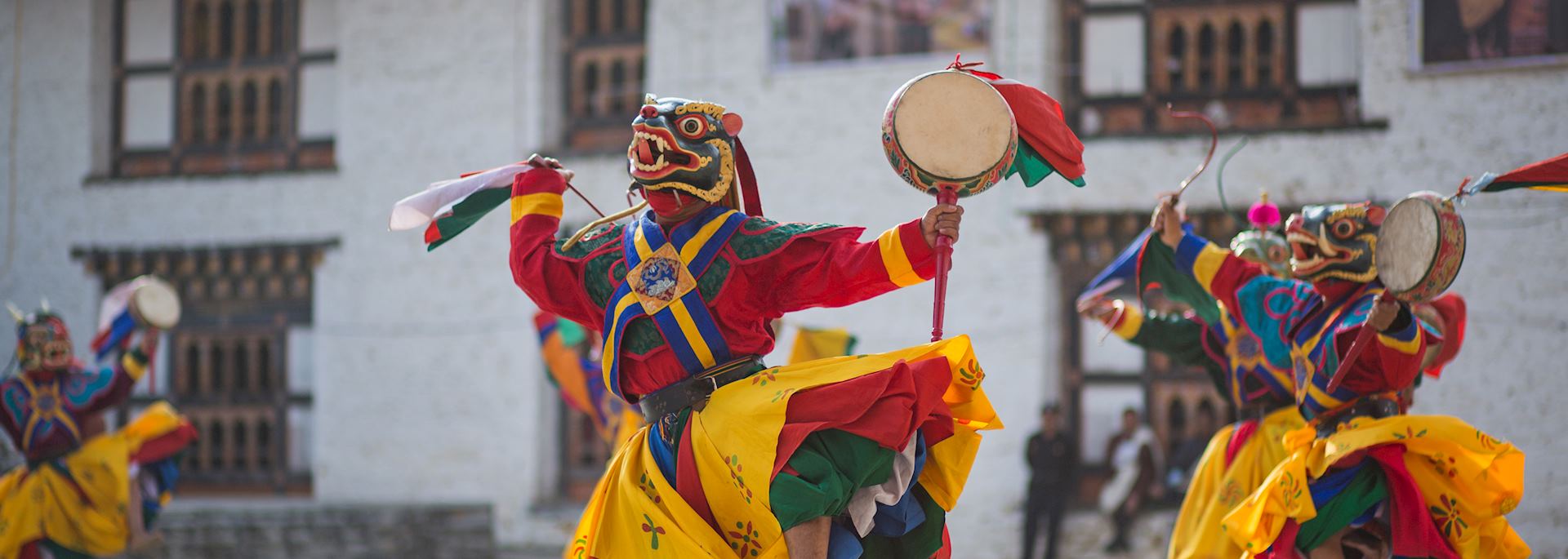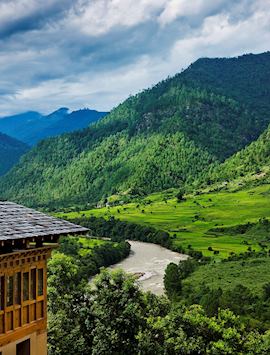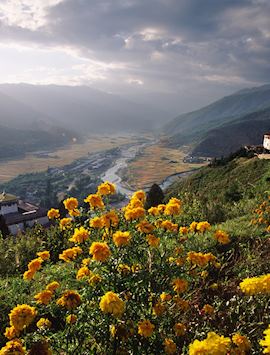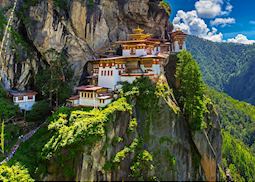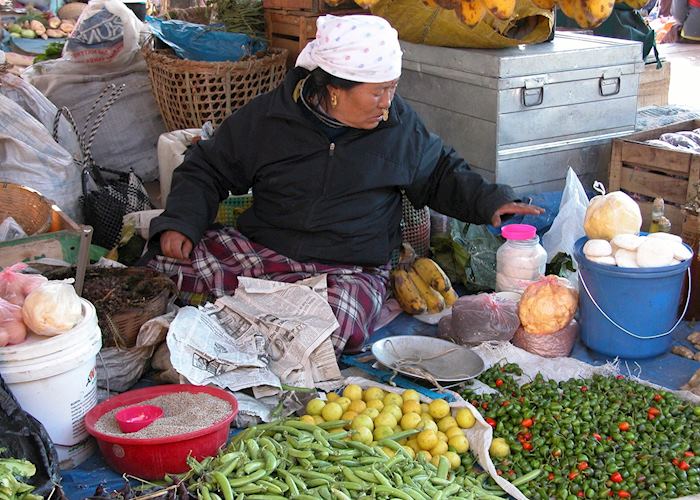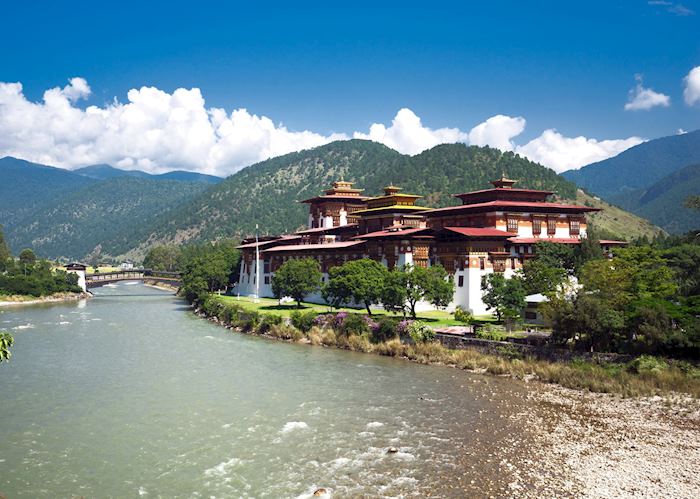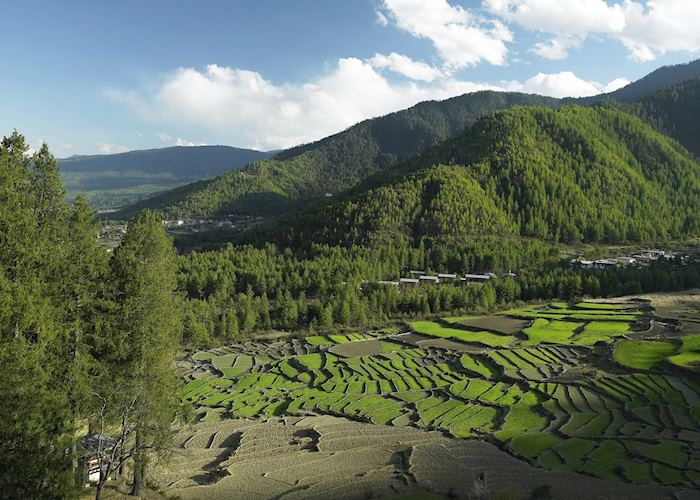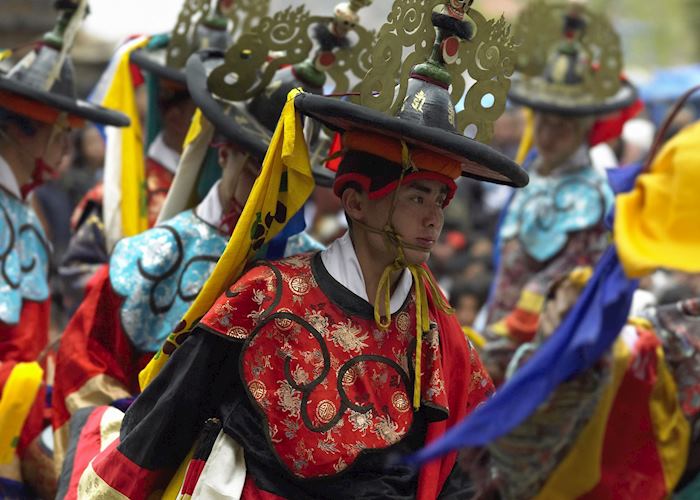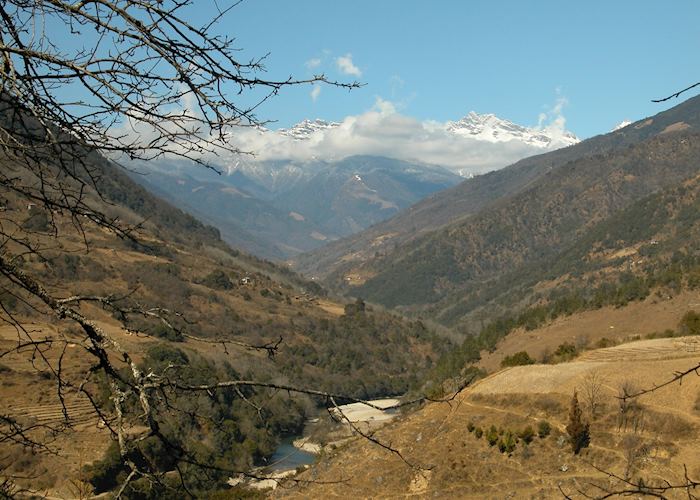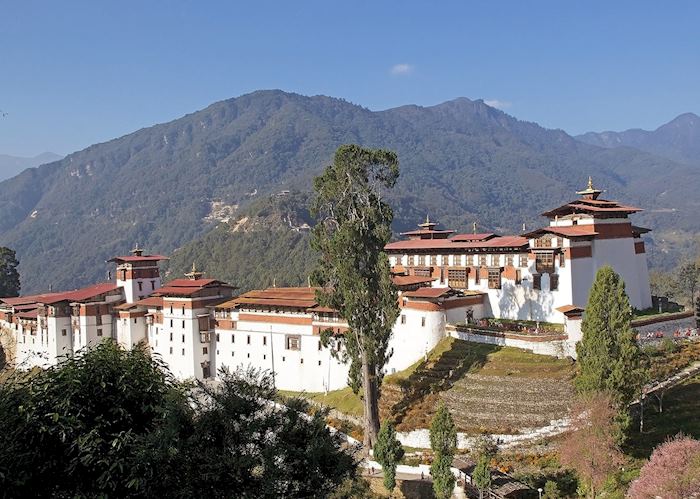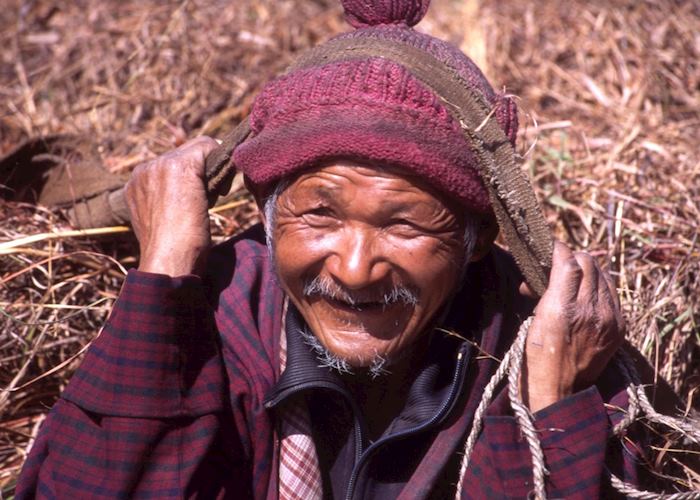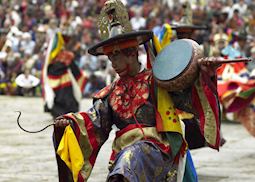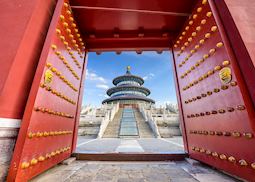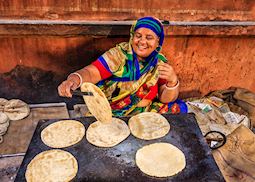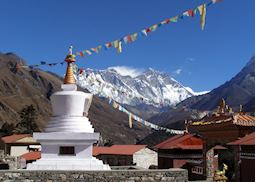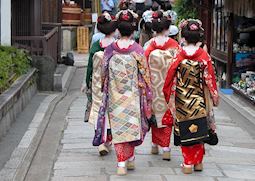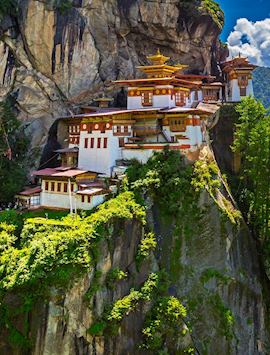
Largely untouched by the modern world, Bhutan is an enigmatic mountain kingdom of green valleys crowned with dzongs (fortresses) and chortens (shrines). As the country operates a strict entry policy, it’s essential that your trip is planned thoroughly. Our specialists will use their extensive knowledge to create a carefully arranged itinerary that’s tailored to your interests. We have also worked hard to find the best drivers and guides (the government requires all visitors are accompanied), who can enhance your holiday to Bhutan.
A journey through Bhutan will take you through rich forests, over high mountain passes and to some of the most biologically diverse national parks in the world. The cliff-hugging Tiger’s Nest is one of many white-walled monasteries that overlook yawning valleys, which burst into bloom with wildflowers in spring. And, you’ll find the Bhutanese welcoming in showing you their deeply Buddhist and traditional way of life, where Gross National Happiness is more important than gross domestic product.
Suggested tours for Bhutan
These tours give you a starting point for what your holiday to Bhutan could entail. Treat them as inspiration, as each trip is created uniquely for you.
Suggested activities for Bhutan
Whatever your interests, our specialists will build activities into your trip that connect to how you want to experience Bhutan.
-
Tiger's Nest Monastery & Drukgyel Dzong ![Paro Taktsang]()
Tiger's Nest Monastery & Drukgyel Dzong
ParoTiger's Nest Monastery & Drukgyel Dzong
The Tiger's Nest Monastery is possibly the most famous in Bhutan, having been founded in the late 1600s, and perched on a high rocky ledge 900 m above the valley floor allegedly at a place where Guru Rinpoche rested, travelling on a flying tiger.
View details -
Punakha Dzong excursion ![Punakha Dzong, Punakha]()
Punakha Dzong excursion
PunakhaPunakha Dzong excursion
Built in 1637, Punakha Dzong served as the seat of the government until the mid 20th century. Over the centuries it has suffered damage from several fires and flooding but still remains one of the most impressive dzongs in Bhutan.
View details -
Ura & Flaming Lake ![Cattle farmer in Ura Village, Bumthang]()
Ura & Flaming Lake
Ura & Flaming Lake
Visit Ura village, lying in the highest of Bumthang's valleys, at around 3,100 m. Ura leads into the easternmost regions of Bhutan and is located immediately below the Thrumshing La (pass) at 3,800 m.
View details
Why travel with Audley?
- 100% tailor-made tours
- Fully protected travel
- Established for over 25 years
- 98% of our clients would recommend us
Best time to visit
Our specialists advise on the best months to visit Bhutan, including information about climate, events and festivals.
Request our brochure
Covering all seven continents, The World Your Way shows you how you can see the world with us. It features trip ideas from our specialists alongside hand-picked stays and experiences, and introduces our approach to creating meaningful travel experiences.
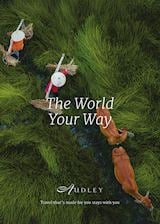
Useful information for planning your holiday in Bhutan
The official language of Bhutan is Dzongkha, but 18 other languages, including Nepali, are also spoken. Students are taught in English at school, so you’ll easily find English speakers almost everywhere you go.
The currency of Bhutan is the ngultrum (Nu or BTN), the value of which is tied to the Indian rupee. Cash is still the preferred method of payment here, although credit cards are accepted in larger hotels and stores, but you may be charged a fee.
You’ll find ATMs in Thimphu, Phuntsholing, Paro, and Punakha, but it’s a good idea to bring some cash, ideally US dollars in smaller denominations.
In Bhutan, you should try traditional food such as ema datshi (chili pepper and yak cheese stew), momos (steamed dumplings), and suja (salted butter tea). Traditional Bhutanese food is often hot and spicy with lots of chilies used alongside meat, vegetables, and red or white rice. Vegetarian food is relatively easy to find.
In Bhutan, meals are often served as a variety of small dishes so you can choose many different recipes in one sitting. Singchang (local beer) is the most popular drink.
There’s no need to tip in Bhutan because hotels and restaurant totals include sales tax and service charges of 20%. The tipping of your guide, driver, and trek crew is at your discretion and your specialist can advise on appropriate amounts closer to your trip.
For the latest travel advice for Bhutan, including entry requirements, health information, and the safety and security situation, please refer to the Foreign, Commonwealth & Development Office website.
A visit to Bhutan offers snow-capped Himalayan peaks, sky-high trekking, traditional culture, and one of the most forward-thinking sustainability policies on Earth. This remote mountain kingdom boasts dzongs (fortified monasteries) that cling to cliffs set against a backdrop of rugged peaks, red-robed monks chanting prayers, prayer flags fluttering in the wind, and yak bells tinkling in the valleys.
Here, you can wander from tropical forests over high mountain passes to villages where regular festivals see communities gather in celebration with masked dancers, singers, and traditional music and dress. The emphasis on low-impact tourism means many of the country’s traditions remain intact and you can explore local markets, and visit monasteries, shrines, and temples, national parks, and villages. And, of course, wherever you go, you can admire the breathless heights of the Himalaya.
In Bhutan, you can stay in luxurious hotels with indulgent spas, traditional Bhutanese buildings converted into guesthouses, and simple lodges overlooking the mountains. Development is strictly curbed in Bhutan and the number and size of hotels is limited.
West and central Bhutan have some of the best hotels, while elsewhere places to stay can be more basic. All our recommendations have en suite bathrooms and often have a bukhari (wood-burning stove) for colder evenings. Some of our preferred options include a luxurious retreat built in traditional style in the Phobjikha Valley, a modern, minimalist-style lodge in the Thimphu Valley, and a serene escape surrounded by pine forests close to Paro. Elsewhere, you’ll find simple local guesthouses and a former palace with traditional styling.
To get a better idea of what’s on offer, take a look at our collection of places to stay in Bhutan.
Paro, Thimpu, Punakha, and the Bumthang Valley are some of Bhutan’s key destinations. Most visitors arrive in Paro from where you can visit the Tiger’s Nest Monastery, which sits on the edge of a sheer cliff. The capital Thimphu is home to the imposing Tashichoe Dzong, and a busy market but it’s also a great place to soak up life in Bhutan and discover some of the kingdom’s deep-seated traditions and religious customs.
You can see the 17th-century Gangtey Gompa monastery in the Phobjikha Valley where the arrival of black-necked cranes is celebrated each winter, while the Punakha dzong is set at the confluence of two rivers and is one of the country’s most striking.
You’ll find Bhutan’s oldest temples in the remote Bumthang Valley where the villages still flourish just as they have for hundreds of year. In the east of the kingdom, animist beliefs thrive in minority villages.
A visit to Bhutan offers snow-capped Himalayan peaks, sky-high trekking, traditional culture, and one of the most forward-thinking sustainability policies on Earth. This remote mountain kingdom boasts dzongs (fortified monasteries) that cling to cliffs set against a backdrop of rugged peaks, red-robed monks chanting prayers, prayer flags fluttering in the wind, and yak bells tinkling in the valleys.
Here, you can wander from tropical forests over high mountain passes to villages where regular festivals see communities gather in celebration with masked dancers, singers, and traditional music and dress. The emphasis on low-impact tourism means many of the country’s traditions remain intact and you can explore local markets, and visit monasteries, shrines, and temples, national parks, and villages. And, of course, wherever you go, you can admire the breathless heights of the Himalaya.
It takes around 15 hours to fly from the UK to Bhutan.
It’s not possible to fly direct from the UK to Bhutan. Paro is the usual entry and exit point to Bhutan, and flights operate from Delhi, Kathmandu, Bangkok, and Calcutta. Bhutan can also be reached overland from India, but it’s a long drive from the border to the main places of interest.
The time zone in Bhutan is UTC+6 hours. Bhutan doesn’t observe Daylight Savings Time.
The best way to get around in Bhutan is by road and we’ll arrange a private vehicle with a driver and guide to take you between destinations. Journeys in Bhutan can be slow as the one main road weaves its way on and out of valleys over the Himalayan foothills and can occasionally be closed by landslides. Delays, however, are more than compensated for by the sweeping scenery around you.
Use our travel tool to find up-to-date visa and passport requirements for Bhutan. Enter where you’re travelling to and from (including any stopover destinations en route or flight layovers), along with your intended travel dates and passport details, for a full list of requirements.
Bhutan’s sustainable development fee is a compulsory daily levy paid by all visitors. It ensures visitor numbers are sustainable and that all citizens benefit from international tourism with proceeds spent on education, infrastructure, and facilities and services.
Your doctor can provide you with vaccine advice for Bhutan, but you should also ensure you’re up to date with the recommended vaccinations for your home country. You can also check the suggested vaccinations on the Travel Health Pro website.
A yellow fever vaccination certificate is required for travellers who are arriving from, or have transited through, countries with risk of yellow fever transmission.
Bhutan in pictures
Our expert guides to travelling in Bhutan
Written by our specialists from the viewpoint of their own travels, these guides will help you decide on the shape of your own trip to Bhutan. Aiming to inspire and inform, we share our recommendations for how to appreciate Bhutan at its best.
-
Festivals of Bhutan ![Paro tsechu, Bhutan]()
Festivals of Bhutan
Festivals of Bhutan
Festivals are very important to Bhutanese people, they're a great excuse to celebrate and socialise. We can highly recommend incorporating a festival into your tailor-made trip to Bhutan, as an ideal way of immersing yourself in the country's culture.
Read this guide -
A guide to hiking to the Tiger’s Nest Monastery ![Paro Taktsang]()
A guide to hiking to the Tiger’s Nest Monastery
A guide to hiking to the Tiger’s Nest Monastery
What’s the best time to visit the Tiger’s Nest Monastery? How hard is the hike? Is it worth it? Our Bhutan specialists have created an FAQ guide to answer all your questions about Bhutan’s best-known sight.
Read this guide -
India to Nepal: where to go in the Himalaya ![Mount Everest, Everest Region]()
India to Nepal: where to go in the Himalaya
India to Nepal: where to go in the Himalaya
Spanning six countries and the world’s highest mountain range, the Himalaya isn’t a region you usually tackle in one go. We compare and contrast the best Himalayan journeys, which include seeking out rhinos in Nepal, visiting remote dzongs in Bhutan, and riding railways in India.
Read this guide
